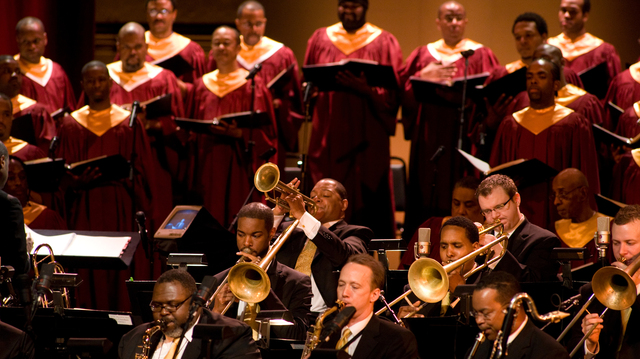 Abyssinian 200 featuring the Jazz at Lincoln Center Orchestra with Wynton Marsalis, the Abyssinian Baptist Church Choir and Rev. Dr. Calvin O. Butts III. (Photo via jalc.org)
Abyssinian 200 featuring the Jazz at Lincoln Center Orchestra with Wynton Marsalis, the Abyssinian Baptist Church Choir and Rev. Dr. Calvin O. Butts III. (Photo via jalc.org)
Tadias Magazine
By Tseday Alehegn
Updated: August 10th, 2008
New York (TADIAS) – As members of Harlem’s legendary Abyssinian Baptist Church, a symbol of African American and Ethiopian relations, prepare for the church’s bicentennial celebration, we offer the following article from our archive that reminds us of the lasting legacies and ties that bind.
Ethiopia, also called Yaltopya, Cush, and Abyssinia, stands as the oldest, continuous, black civilization on earth, and the second oldest civilization in history after China. This home of mine has been immortalized in fables, legends, and epics. Homer’s Illiad, Aristotle’s A Treatise on Government, Miguel Cervante’s Don Quixote, the Bible, the Koran, and the Torah are but a few potent examples of Ethiopia’s popularity in literature. But it is in studying the historical relations between African Americans and Ethiopians that I came to understand ‘ Ethiopia’ as a ray of light. Like the sun, Ethiopia has spread its beams on black nations across the globe. Her history is carefully preserved in dust-ridden books, in library corners and research centers. Her beauty is caught by a photographer’s discerning eye, her spirituality revived by priests and preachers. Ultimately, however, it is the oral journals of our elders that helped me capture glitters of wisdom that would palliate my thirst for a panoptic and definitive knowledge.
The term ‘Ethiopian’ has been used in a myriad of ways; it is attributed to the indigenous inhabitants of the land located in the Eastern Horn of Africa, as well as more generally denotive of individuals of African descent. Indeed, at one time, the body of water now known as the Atlantic Ocean was known as the Ethiopian Ocean. And it was across this very ocean that the ancestors of African Americans were brought to America and the ‘ New World.’
Early African American Writers
Although physically separated from their ancestral homeland and amidst the opprobrious shackles of slavery, African American poets, writers, abolitionists, and politicians persisted in forging a collective identity, seeking to link themselves figuratively if not literally to the African continent. One of the first published African American writers, Phillis Wheatly, sought refuge in referring to herself as an “Ethiop”. Wheatley, an outspoken poet, was also one of the earliest voices of the anti-slavery movement, and often wrote to newspapers of her passion for freedom. She eloquently asserted, “In every human breast God has implanted a principle, it is impatient of oppression.” In 1834 another anti-slavery poet, William Stanley Roscoe, published his poem “The Ethiop” recounting the tale of an African fighter ending the reign of slavery in the Caribbean. Paul Dunbar’s notable “Ode to Ethiopia,” published in 1896, was eventually put to music by William Grant Still and performed in 1930 by the Afro-American Symphony. In his fiery anti-slavery speech entitled “What to the Slave is the Fourth of July?” prominent black leader Frederick Douglas blazed at his opponents, “Africa must rise and put on her yet unwoven garment. Ethiopia shall stretch out her hand unto God.”
First Ethiopians Travel to America
As African Americans fixed their gaze on Ethiopia, Ethiopians also traveled to the ‘New World’ and learned of the African presence in the Americas. In 1808 merchants from Ethiopia arrived at New York’s famous Wall Street. While attempting to attend church services at the First Baptist Church of New York, the Ethiopian merchants, along with their African American colleagues, experienced the ongoing routine of racial discrimination. As an act of defiance against segregation in a house of worship, African Americans and Ethiopians organized their own church on Worth Street in Lower Manhattan and named it Abyssinia Baptist Church. Adam Clayton Powell, Sr. served as the first preacher, and new building was later purchased on Waverly Place in the West Village before the church was moved to its current location in Harlem. Scholar Fikru Negash Gebrekidan likewise notes that, along with such literal acts of rebellion, anti slavery leaders Robert Alexander Young and David Walker published pamphlets entitled Ethiopian Manifesto and Appeal in 1829 in an effort to galvanize blacks to rise against their slave masters.
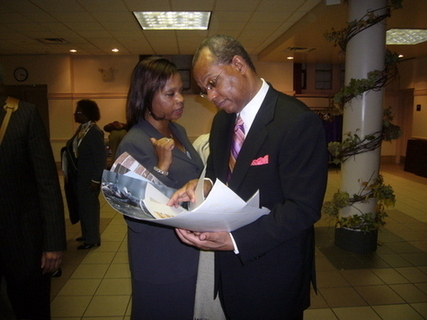
Above: Reverend Dr. Calvin O. Butts, III, current head of the Abyssinia
Baptist Church in Harlem, led a delegation of 150 to Ethiopia in 2007 as
part of the church’s bicentennial celebration and in honor of the Ethiopian
Millennium. Photo: At Abyssinian Baptist Church in Harlem on Sunday,
November 4, 2007. (Tadias)
Adwa Victory &‘Back to Africa’ Movement
When Italian colonialists encroached on Ethiopian territory and were soundly defeated in the Battle of Adwa on March 1, 1896, it became the first African victory over a European colonial power, and the victory resounded loud and clear among compatriots of the black diaspora. “For the oppressed masses Adwa…would become a cause célèbre,” writes Gebrekidan, “a metaphor for racial pride and anti-colonial defiance, living proof that skin color or hair texture bore no significance on intellect and character.” Soon, African Americans and blacks from the Caribbean Islands began to make their way to Abyssinia. In 1903, accompanied by Haitian poet and traveler Benito Sylvain, an affluent African American business magnate by the name of William Henry Ellis arrived in Ethiopia to greet and make acquaintances with Emperor Menelik. A prominent physician from the West Indies, Dr. Joseph Vitalien, also journeyed to Ethiopia and eventually became the Emperor’ trusted personal physician.
For black America, the early 1900s was a time consumed with the notion of “returning to Africa,” to the source. With physical proof of the beginnings of colonial demise, a charismatic and savvy Jamaican immigrant and businessman named Marcus Garvey established his grassroots organization in 1917 under the title United Negro Improvement Association (UNIA) with branches in various states. Using the success of Ethiopia’s independence as a beacon of freedom for blacks residing in the Americas, Garvey envisioned a shipping business that would raise enough money and register members to volunteer to be repatriated to Africa. In a few years time, Garvey’s UNIA raised approximately ten million dollars and boasted an impressive membership of half a million individuals.
Notable civil rights leader Malcolm X began his autobiography by mentioning his father, Reverend Earl Little, as a staunch supporter of the UNIA. “It was only me that he sometimes took with him to the Garvey U.N.I.A. meetings which he held quietly in different people’s homes,” says Malcolm. “I can remember hearing of ‘ Africa for the Africans,’ ‘Ethiopians, Awake!’” Malcolm’s early association with Garvey’s pan-African message resonated with him as he schooled himself in reading, writing, and history. “I can remember accurately the very first set of books that really impressed me,” Malcolm professes, “J.A. Rogers’ three volumes told about Aesop being a black man who told fables; about the great Coptic Christian Empires; about Ethiopia, the earth’s oldest continuous black civilization.”
By the time the Ethiopian government had decided to send its first official diplomatic mission to the United States, Marcus Garvey had already emblazoned an image of Ethiopia into the minds and hearts of his African American supporters. “I see a great ray of light and the bursting of a mighty political cloud which will bring you complete freedom,” he promised them, and they in turn eagerly propagated his message.
The Harlem Renaissance & Emigrating to Ethiopia
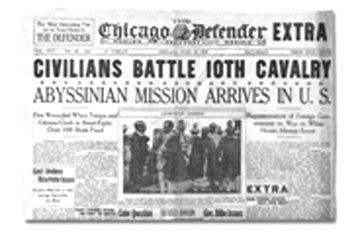
Above: A headline by the Chicago Defender announcing the
arrival of the first Abyssinian diplomatic delegation to the United
States on July 11, 1919.
In 1919 an official Ethiopian goodwill mission was sent to the United States, the first African delegation of diplomats, in hopes of creating amicable ties with the American people and government. The four-person delegation included Dadjazmatch Nadou, Ato Belanghetta Herouy Wolde Selassie, Kantiba Gabrou, and Ato Sinkas. Having been acquainted with African Americans such as businessman William Ellis, Kantiba Gabrou, the mayor of Gondar, made a formal appeal during his trip for African Americans to emigrate to Ethiopia. Arnold Josiah Ford, a Harlem resident from Barbados, had an opportunity to meet the 1919 Ethiopian delegation. Having already heard of the existence of black Jews in Ethiopia, Ford established his own synagogue for the black community soon after meeting the Ethiopian delegation. Along with a Nigerian-born bishop named Arthur Wentworth Matthews, Ford created the Commandment Keepers Church on 123rd Street in Harlem and taught the congregation about the existence of black Jews in Ethiopia. Meanwhile, in the international spotlight, 1919 was the year the League of Nations was created, of which Ethiopia became the first member from the African continent. The mid 1900s gave birth to the Harlem Renaissance. With many African Americans migrating to the north in search of a segregation-free life, and a large contention of black writers, actors, artists and singers gathering in places like Harlem, a new culture of black artistic expression thrived. Even so, the Harlem Renaissance was more than just a time of literary discussions and hot jazz; it represented a confluence of creativity summoning forth the humanity and pride of blacks in America – a counterculture subverting the grain of thought ‘separate and unequal.’
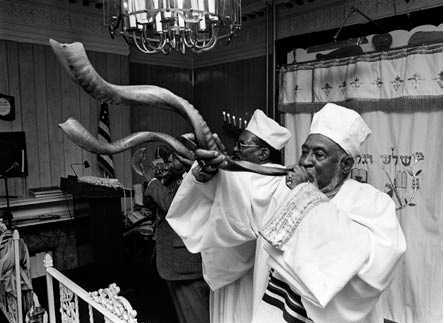
Above: Commandment Keepers Synagogue.. Photography by Chester Higgins.
©chesterhiggins.com
As in earlier times, the terms ‘Ethiopian’ and ‘Ethiop’ continued to be utilized by Harlem writers and poets to instill black pride. In other U.S. cities like Chicago, actors calling themselves the ‘National Ethiopian Art Players’ performed The Chip Woman’s Fortune by Willis Richardson, the first serious play by a black writer to hit Broadway.
In 1927, Ethiopia’s Ambassador to London, Azaj Workneh Martin, arrived in New York and appealed once again for African American professionals to emigrate and work in Ethiopia. In return they were promised free land and high wages. In 1931 the Emperor granted eight hundred acres for settlement by African Americans, and Arnold Josiah Ford, bishop of the Commandment Keepers Church, became one of the first to accept the invitation. Along with sixty-six other individuals, Ford emigrated and started life anew in Ethiopia.
Ethiopian Students in America: Mobilizing Support
In November 1930, Taffari Makonnen was coronated as Emperor of Ethiopia. The event blared on radios, and Harlemites heard and marveled at the ceremonies of a black king. The emperor’s face glossed the cover of Time Magazine, which remarked on “negro newsorgans” in America hailing the king “as their own.” African American pilot Hubert Julian, dubbed “The Black Eagle of Harlem,” had visited Ethiopia and attended the coronation. Describing the momentous occasion to Time Magazine, Hubert rhapsodized:
“When I arrived in Ethiopia the King was glad to see me… I took off with a French pilot… We climbed to 5,000 ft. as 50,000 people cheered, and then I jumped out and tugged open my parachute… I floated down to within 40 ft. of the King, who incidentally is the greatest of all modern rulers… He rushed up and pinned the highest medal given in that country on my breast, made me a colonel and the leader of his air force — and here I am!”
Joel Augustus Rogers, famed author and correspondent for New York’s black newspaper Amsterdam News, also covered the Coronation of Haile Selassie and was likewise presented with a coronation medal.
After his official coronation, Emperor Haile Selassie sent forth the first wave of Ethiopian students to continue their education abroad. Melaku Beyan was a member of the primary batch of students sent to America in the 1930s. He attended Ohio State University and later received his medical degree at Howard Medical School in Washington, D.C. During his schooling years at Howard, he forged lasting friendships with members of the black community and, at Emperor Haile Selassie’s request, he endeavored to enlist African American professionals to work in Ethiopia. Beyan was successful in recruiting several individuals, including teachers Joseph Hall and William Jackson, as well as physicians Dr. John West and Dr. Reuben S. Young, the latter of whom began a private practice in Ethiopia’s capital, Addis Ababa, prior to his official assignment as a municipal health officer in Dire Dawa, Harar.
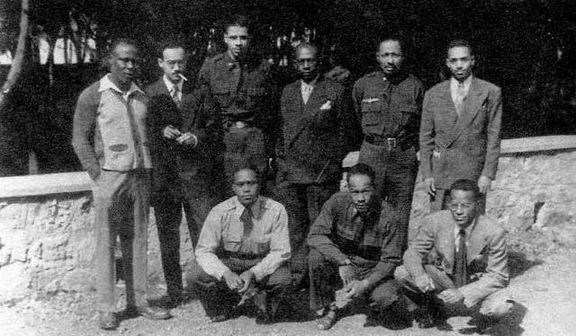
African American professionals in Addis Ababa – 1942. Kneeling, left to right: Andrew
Howard Hester, Edward Eugene Jones, Edgar E. Love. Standing, left to right: David Talbot, Thurlow
Evan Tibbs, James William Cheeks, the Reverend Mr. Hamilton, John Robinson, Edgar D. Draper
(Ethiopiancrown.org)
Italo-Ethiopian War 1935-1941
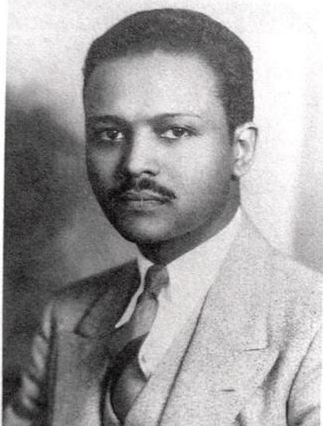
Melaku Beyan
By the mid 1930s the Emperor had sent a second diplomatic mission to the U.S. Vexed at Italy’s consistently aggressive behavior towards his nation, Haile Selassie attempted to forge stronger ties with America. Despite being a member of the League of Nations, Italy disregarded international law and invaded Ethiopia in 1935. The Ethiopian government appealed for support at the League of Nations and elsewhere, through representatives such as the young, charismatic speaker Melaku Beyan in the United States. Beyan had married an African American activist, Dorothy Hadley, and together they created a newspaper called Voice of Ethiopia to simultaneously denounce Jim Crow in America and fascist invasion in Ethiopia. Joel Rogers, the correspondent who had previously attended the Emperor’s coronation, returned to Ethiopia as a war correspondent for The Pittsburgh Courier, then America’s most widely-circulated black newspaper. Upon returning to the United States a year later, he published a pamphlet entitled The Real Facts About Ethiopia, a scathing and uncompromising report on the destruction caused by Italian troops in Ethiopia. Melaku Beyan used the pamphlet in his speaking tours, while his wife Dorothy designed and passed out pins that read “Save Ethiopia.”
In Harlem, Chicago, and various other cities African American churches urged their members to speak out against the invasion. Beyan established at least 28 branches of the newly-formed Ethiopian World Federation, an organ of resistance calling on Ethiopians and friends of Ethiopia throughout the United States, Europe, and the Caribbean. News of Ethiopia’s plight fueled indignation and furious debates among African Americans. Touched by the Emperor’s speech at the League of Nations, Roger’s accounts, and Melaku’s impassioned message, blacks vowed to support Ethiopia. Still others wrote letters to Haile Selassie, some giving advice, others support and commentary. “I pray that you will deliver yourself from crucifixion,” wrote one black woman from Los Angeles, “and show the whites that they are not as civilized as they loudly assert themselves to be.”
Although the United States was not officially in support of Ethiopia, scores of African Americans attempted to enlist to fight in Ethiopia. Unable to legally succeed on this front, several individuals traveled to Ethiopia on ‘humanitarian’ grounds. Author Gail Lumet Buckley cites two African American pilots, John Robinson and the ‘Black Eagle of Harlem’ Hubert Julian, who joined the Ethiopian Air Corps, then made up of only three non-combat planes. John Robinson, a member of the first group of black students that entered Curtis Wright Flight School, flew his plane delivering medical supplies to different towns across the country. Blacks in America continued to stand behind the Emperor and organized medical supply drives from New York’s Harlem Hospital. Melaku Beyan and his African American counterparts remained undeterred for the remainder of Ethiopia’s struggle against colonization. In 1940, a year before Ethiopia’s victory against Italy, Melaku Beyan succumbed to pneumonia, which he had caught while walking door-to-door in the peak of winter, speaking boldly about the war for freedom in Ethiopia.
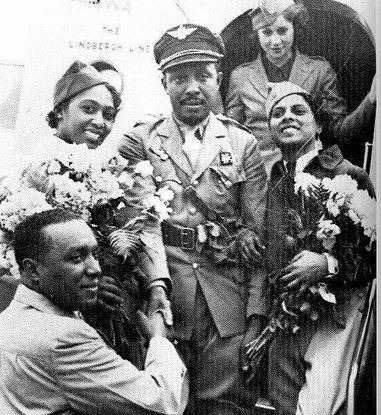
Above: Colonel John C. Robinson arrives in Chicago after heroically
leading the Ethiopian Air Force against the invading Mussolini’s
Italian forces. (Ethiopiancrown.org)
Lasting Legacies: Ties That Bind
Traveling through Harlem in my mind’s eye, I see the mighty organs of resistance that played such a pivotal role in “keeping aloft” the banner of Ethiopia and fostering deep friendships among blacks in Africa and America. I envision the doors Melaku Beyan knocked on as he passed out pamphlets; the pulpits on street corners where Malcolm X stood preaching about the strength and beauty of black people, fired up by the history he read. The Abyssinia Baptist Church stands today bigger and bolder, and inside you find the most exquisite Ethiopian cross, a gift from the late Emperor to the people of Harlem and a symbol of love and gratitude for their support and friendship.
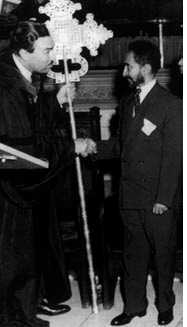
Above: Emperor Haile Selassie
presenting the cross to Reverened
Adam Clayton Powell, Jr., on May 27,
1954. Photography by Marvin Smith.
Several Coptic churches line the streets of Harlem, and the ancient synagogue of the Commandment Keepers established by Arnold Ford continues to have Sabbath services. The offices of the Amsterdam News are still as busy as ever, recording and recounting the past and present state of black struggles. Over the years, the Schomburg Center for Research in Black Culture has carefully preserved the photographic proofs of the ties that bind African Americans and Ethiopians, just in case the stories told are too magical to grasp.The name ‘Ethiopia’ conjures a kaleidoscope of images and verbs. In researching the historical relations between African Americans and Ethiopians, I learned that Ethiopia is synonymous with ‘freedom,’ ‘black dignity’ and ‘self-worth.’ In the process, I looked to my elders and heeded the wisdom they have to share. In his message to the grassroots of Detroit, Michigan, Malcolm X once asserted, “Of all our studies, history is best qualified to reward our research.” It is this kernel of truth that propelled me to share this rich history in celebration of Black History Month and the victory of Adwa.
In attempting to understand what Ethiopia really means, I turn to Ethiopia’s Poet Laureate Tsegaye Gabre-Medhin. “The Ethiopia of rich history is the heart of Africa’s civilization,” he said. “She is the greatest example of Africa’s pride. Ethiopia means peace. The word ‘ Ethiopia’ emanates from a connection of three old black Egyptian words, Et, Op and Bia, meaning truth and peace, up and upper, country and land. Et-Op-Bia is land of upper truth or land of higher peace.”
This is my all-time, favorite definition of Ethiopia, because it brings us back to our indigenous African roots: The same roots that African Americans and black people in the diaspora have searched for; the same roots from which we have sprung and grown into individuals rich in confidence. Welcome to blackness. Welcome to Ethiopia!
About the Author:

Tseday Alehegn is the Editor-in-Chief of Tadias Magazine. Tseday is a graduate of Stanford University (both B.A. & M.A.). In addition to her responsibilities at Tadias, she is also a Doctoral student at Columbia University.
Related: Harlem rekindles old friendship (Tadias)
The Case of Melaku E. Bayen & John Robinson (Tadias)


























This has to be an award winning article!!
Thank you so much Tadias and thank you Tseday for a well researched and well intentioned story.
Tadias, I love you!
Sadly, due in part to very heated internal fractures among the membership, the commandment keepers synagogue has closed…Rabbi Finias Cuypers in Chicago and others cointue the legacy. I had the pleasure of listening to a lecture and meeting Rabbi Matthews when I was in law school in Ohio.
Terrence
This Is very good!
Thank you very much. It is wonderful and uplifting to read about Ethiopia and its great people.
Though at the moment, we are spread out all over the world, once our ancestor’s were greater than most of the nations..
If you can manage to read Amharic let me write one of the poem of the times in Amharic language, I hope you can understand it.
enkwan ezhe meto egeza agerachen
roman yasbal gegna newe lebachen
When you translate it into English, it reads something like this: Let alone him (Mussolini) coming to fight us in our own territory in our soil to be defeated; we are thinking of Rome since we are brave to fight and conquer his own country
May the Lord bless you abundantly and thank you!
What a wonderful read ! A very facinating and well written article… Keep up the good work.
Fesseha ( California)
Most insightful. I have looked for years for a comprehensive article on this subject as, sadly, far too many African-Americans are not even aware of this facet of history. Moreover, US Spanish Civil War Veterans are greatly hailed, while true heroes and humanitarians, such as Col. John C. Robinson, go unnoticed and quickly fade into obscurity. This article is a great teaching tool and deserves much wider and more aggressive publication.